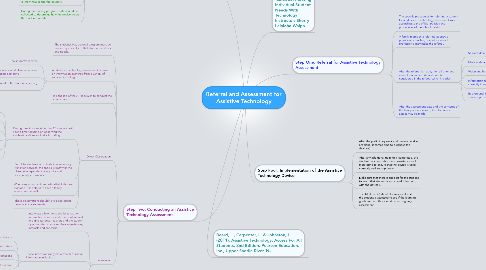
1. Step Two: Conducting an Assistive Technology Assessment
1.1. The student’s instructional program must be tailored specifically to that student’s abilities and needs.
1.2. An Assistive Technology assessment is based on information gathered from a variety of sources, including:
1.2.1. The student's records
1.2.2. Additional informal observations and information gathering
1.2.3. Formal assessment of the student's existing skills
1.3. It is the job of the AT specialist to conduct the assessment
1.4. Direct Observation
1.4.1. During direct observation, the AT specialist will spend time focusing on observing the student’s abilities and skills including:
1.4.1.1. Cognitive skills
1.4.1.2. Current use of any AT devices
1.4.1.3. Sensory skills
1.4.1.4. Motor skills
1.4.1.5. Communication skills
1.4.1.6. Social skills
1.4.2. For older students with disabilities receiving transition services, the specialist may want to observe independent living skills and vocational performance
1.4.3. When very young children with disabilities are assessed, it is helpful to have a family assessment as well
1.4.4. These observations should take place across times and environments
1.5. Interviews
1.5.1. Interviews allow the specialist to gather information about specific areas of interest and give parents, teachers and the student opportunities to express their experiences, interests and concerns.
1.5.2. These interviews can yield a wealth of useful information including:
1.5.2.1. Family concerns and expectations
1.5.2.2. Perceived needs and abilities of the student
1.5.2.3. Academic expectations
1.5.2.4. Diagnostic information
1.5.2.5. Medical information
1.5.3. For older students with disabilities, the interview should include independent living skills and vocational performance
1.5.4. As a service provider, teacher or family member, you may be asked to address these matters
1.6. Formal Assessment
1.6.1. Involves selected activities in predetermined environments
1.6.2. The specialist may need to match assessments and parts of assessments to the student with regard to age, experiences, cognitive level, behavioral issues and social skills
1.7. Putting It All Together
1.7.1. When the referral, information gathering and assessment procedures are completed, the AT specialist will be able to construct a comprehensive picture of the student’s strengths and needs.
1.7.2. A formal written report will be compiled by the specialist and then presented
2. Step Three: The Individualized Education Program Team
2.1. Decisions will be based on the report given by the AT specialist and in light of other information found
2.2. Decisions including training for those who work with the student will also be determined by the AT specialist
2.3. Device Trials
2.3.1. After the team decides that the student needs AT for access and support and determines the device or devices the student may need, it is time for the team to procure the device.
2.3.2. The team must do their research in order to get the correct device(s) needed for the student and to make sure that the device(s) are within their budget
2.3.3. People working closely with the student need to know how to use the device(s)
2.3.4. During the training program, data should be collected to determine how the device meets the student’s needs
3. Beard, L., Carpenter, L. & Johnston, L. (2011). Assistive Technology: Access For All Students. 2nd Edition. Pearson Education, Inc., Upper Saddle River, NJ.
4. Step One: Referral for Assistive Technology Assessment
4.1. The specific procedures for referring a student for an Assistive Technology assessment vary according to the official policies and procedures of the school district
4.2. A family member, a referring agency, a physician, a teacher, or another school professional may make the referral.
4.3. After the referral is made, then all prior and current assessment data should be considered in the referral which includes:
4.3.1. Student data or personal information
4.3.2. Medical data for vital concerns
4.3.3. Vision and hearing reports
4.3.4. Information about any technology or equipment currently in use
4.3.5. Background information regarding any related services provided previously for the student
